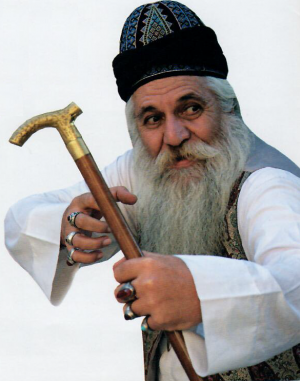Mohammad ahadi
Darvish Mohammad Ahadi (born in 1952) is a distinguished Iranian Pardekhan and T’aziyakhan. Patience and dignity, command over the melodies, stories, actions and movements of curtain-storytelling, the appropriateness of his face and stature, all are reasons for Morshed Ahadi becoming known as one of the most prominent picture-storytellers of Iran.
Performance MethodEdit
At times his movements quicken along with his words, while he patiently paces out the pauses and silences with self-confidence. His piercing regards to the audience with his slow pace of performance, his fusion of different fast and slow rhythms in motion add to the lasting influence of his presence and reveals a magnificent composition of his performance. His command of the master's wand (metraq , ta'limi or mantasha') in his theatrical performance is effective in his use of hand , face and body sign language which help transmit concepts , along with use of costume , the painted curtain and authentic objects in harmony with the stories , are all particularities of his performance .
Singing MethodEdit
Morshed Ahadi usually chant in Mahur and Avaz e Bayat e Tork'.In this collection, he begins in the name of Allah with the Avaz e Bayat e Tork and in these same intervals he sings the first verse. Then, he goes to the fourth note of the first Dong, concluding on the Goshayesh' note (second note of the first Dong) , and ends with the verse Haqqa ke adab... in Daramad of Mahur. In continuing he remains within these same intervals (first Dong to the second note of the second Dong). In continuing after the spoken declamation section, he recites the hemistich Del ke ranjid az kasi ... with an accent on the fourth and fifth notes of Mahur mode (the most important notes in Feyli Gushe) and in continuation he chants the poem with the emphasis in the first Dong based on meaning of the poem. The mentioned examples show Morshed Mohammad Ahadi's mastery in expressing the melodies with picture - storytelling techniques. This method is not based on the frequency of melodies. The Morshed or performer, lets his chanting be guided, such as to correspond the general needs of the interpretation of the song, in relation to the narrated words, the painted images and the main goal, that is, the content and subject of the picture-storytelling.
1. Bayat e Tork the first tetrachords of Bayat e Tork and Mahur can be compared if they have the same Shahed note.
2. Goshavesh means introduction. In the past Mahur used to begin with this Gushe but today this Gushe has become secondary in importance and has retained but its name. The figure of the martyred Ali Akbar is usually lying down with his head on the knee of Imam Hussain. On the unique curtain painted by Mohammad Farahani with which Darvish Ahadi works and sings, Ali Akbar is illustrated in a sitting position. The curtain is more than a few decades old. The faces are distinguished and the gatherings are painted in the traditional ways. The only other difference separating this curtain from the other curtains is the gathering and face replacement which is a normal difference found in all curtains.
Since in the curtains of Darvish Farahani only four large faces have been depicted of which the changes in position of the figure of Ali Akbar is very noticeable and raises a question. This scene of seated Ali Akbar is only found in two of the hundreds of curtains made by Mohammad Farahani. One of the reasons for the request is perhaps to create some difference with other curtains and another reason rises perhaps from the belief in the martyrs being alive. The open eyes of most of the martyrs on the darvish curtains are related to the same interpretation.
NarrationEdit
Jacob, the prophet, loses his wife after Yusef (Joseph) was born. He buys a bondswoman from the bazaar so that she would feed Yusef beside her own babies. One day Jacob understands that the bondswoman is unkind to Yusef, for this reason got angry and took her boy and sells him in the bazaar. The mother's heart is broken, and cries for help to her God to keep Yusef away from his father. Yusef (Joseph) the son of Jacob the prophet, because of the envy of his brothers was thrown into a well. A caravan passing by saves him. Yusef arrives at the city and is sold at the marketplace, and since he is very handsome, he is bought by the royalty. His fame for beauty attracts Zuleikha who is the king of Egypt's wife. Finally, a miracle ends the tragedy and the love of Yusef and Zuleikha is materially realized. After 40 years Yusef gives his shirt as a sign that he is alive on God's order. The messenger is the bondswoman son who is now strong youth.
SourceEdit
- Ardalan, hamidreza (2008). Picture-storyteller masters of iran, the Iranian academy of the art, 2008, volume 20. ISBN: 978-964-2986-064(vol.20). 978-964-2986-002(set).
